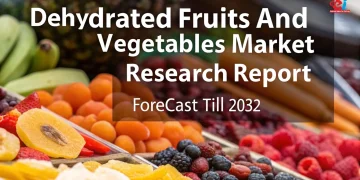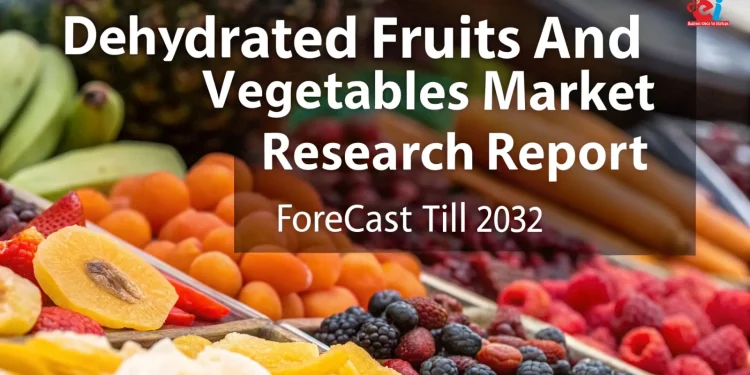The dehydrated fruits and vegetables industry has experienced an impressive growth rate, fueled by changing consumer preferences towards convenience, longer shelf lives, and healthier snacks. Market forecasts indicate that it will grow until 2032, providing an opportunity for entrepreneurs and companies looking to enter the fast-growing food processing sector.
The report is based on extensive information from the annual 2024 industry publication, “Dehydrated Fruits and Vegetables Market Insight 2024,” which forecasts new trends for the future, demand by regions, and application breakdowns, providing entrepreneurs with a strategic plan of action and MSMEs.
1. Market Overview & Forecast
1.1 Global Market Size & CAGR
At the time of the 2023 baseline report, the global dehydrated fruits and vegetables market was estimated to be US$12.5 billion, with an estimated CAGR of 7.8 percent projected between 2024 and 2032. This is due to the growing demand in both emerging and developed countries, driven by a growing awareness of health and the trend of eating more conveniently.
In 2032, the total market size is predicted to reach US$24.7 billion. That’s almost doubled over the course of a decade.
Table 1: Market Size Forecast (USD Billion)
| Year | Market Size |
| 2023 | 12.5 |
| 2025 | 14.0 |
| 2028 | 17.5 |
| 2030 | 21.0 |
| 2032 | 24.7 |
Related: Dehydrated Fruits and Vegetables Market: Driving Growth Through Technological Innovation
1.2 Regional Growth Dynamics
Regional contributions vary based on the patterns of consumption, economics, and infrastructure
- North America: Mature market and growing due to convenience foods, home cooking kits.
- Europe: Health and wellness emphasis; steady year-to-year growth rate of ~6.5 percent.
- Asia-Pacific fastest-growing region at ~9.2 percent CAGR; urbanization, expansion of retail, and the demand for processed foods.
- The Rest of the World (RoW) A growing demand for niche products within Latin America, the Middle East and Africa. Expected ~7.5 percent CAGR for the region.
Pie Chart Description
- Asia-Pacific: 35%
- North America: 28%
- Europe: 25%
- RoW: 12%
2. By Application Segment
Consumers prefer dehydrated goods across different channels:
| Application | 2023 Share (%) | 2032 Forecast (%) | Trends & Drivers |
| Supermarket/Hypermarket | 40 | 37 | Wide distribution; private-label penetration |
| Specialty Retailers | 18 | 22 | Premium, organic, artisanal product demand |
| Convenience Stores | 12 | 10 | On-the-go snacks, urban snacking needs |
| E-Commerce | 20 | 27 | The popularity of online grocery is growing as well as the pandemic of the old |
| Others (Foodservice etc.) | 10 | 4 | Industrial and bulk use, declining amid shifts in regulations |
E-commerce is expected to see significant growth, thanks to increasing internet-based grocery sales and the D2C brand’s expansion.- The specialty retailers increasingly carry natural, clean-label products, increasing their share of the market.
- Supermarkets/hypermarkets maintain a significant share due to volume and private-label scale.
3. By Product Type
3.1 Dehydrated Fruits in Comparison to Vegetables
The market is divided into:
- Dehydrated Fruits – 60% of the market volume; consumed all year round, and widely utilized in snack foods, cereals and baking.
- Dehydrated Vegetables – 40 percent They are used in soups and ready meals, infant food, and nutritional supplements.
Growth Insights:
- Dehydrated fruits CAGR of ~8.2 percent through 2032. The most popular flavors are apples chips and banana mango rolls as well and blueberry powder.
- Dehydrated Vegetables: CAGR of ~7.0%. Demand for carrots, peas, tomatoes, and spinach due to their practical and flavor-related applications in convenience food.
Infographic Summary:
A two-bar graphic that shows the segments of fruit (~60 percent) in comparison to. vegetable (~40 percent) from 2023. They are both growing until 2032.
Related: Food Processing Industry – Fruits, Vegetables and Food Processing
4. Regional Deep Dive
4.1 North America
- The size of the market (2023): US $3.5 billion
- CAGR (2024-2032): ~5.5%
- A huge demand for premium supermarkets, as well as private label brands.
- Companies are entering the market with differentiation, Dehydration, freeze-drying and exotic cooperatives.
- Conformity to regulations: FDA approvals for clean-label and allergen-free processing.
4.2 Europe
- The size of the market (2023): US $3.1 billion
- CAGR: ~6.5%
- Demand from consumers for plant-based, organic, and shelf-stable food items.
- Germany, UK, and France lead; southern Europe is adopting Mediterranean-inspired flavors (sun-dried tomatoes, olives).
- Example: In Germany, the dehydrated fruits and vegetables blends increased by 13% in retail sales in 2023 as per the NPCS annual report.
4.3 Asia-Pacific
- Volume of Market (2023): US$4.4 billion
- CAGR: ~9.2% (fastest globally)
- Urban middle-class families are in desperate need of pre-cooked ingredients.
- Manufacturers invest in a variety of efficient Rotary dryers and vacuum belt dryers. Solar-dehydration facilities and freeze-dryers across India, China, and Thailand.
- India’s plant-based snack market — dehydrated mango slices as well as tamarind snacks — increased by around 15% by 2023.
4.4 Rest of the World
- Market size (2023): US$1.5 billion
- CAGR: ~7.5%
- Opportunities in regional pockets: Latin America (maize, tomato powders), Middle East (spinach and mixtures of peppers), Africa (sorghum, indigenous fruits).
- Barriers to quality (shelf life packaging) offer opportunities for investment as well as technology transfer.
5. Drivers, Challenges & Opportunities
5.1 Key Growth Drivers
- Shelf Life and Convenience Dehydrated fruits and vegetables provide portability and stability of storage. This is crucial to a modern lifestyle.
- Health and Nutrition: Most often preserve the nutrients that are present; “clean label” and 100 percent fruit content are powerful selling points.
- The growth of e-commerce in 2023 saw online grocery sales surpass US$450 billion, and dehydrated food increased its share.
- Private label and contract manufacturing: Large retailers search for affordable dehydrated fruits and vegetables products that are cost-effective, and OEM opportunities arise.
5.2 Challenges
- Price volatility: Both fruits and vegetables are subject to seasonal price fluctuations, which affect the cost of raw materials.
- Technical hurdles: Achieving consistency in texture and quality of rehydration could require capital-intensive drying technology.
- Logistics and Packaging: Properly securing moisture, as well as Modified atmosphere Packaging (MAP) and cold-chain exports, increases costs.
- Regulation Compliance: Conformity to the food safety guidelines (ISO 22000/HACCP), Limits on chemical residues, as well as phytosanitary standards for export.
5.3 Opportunities for Startups
- Niche Flavors: Indigenous fruits, exotic blends, functional vegetable powders.
- Organic and Clean-label brands premium positioning, particularly for North America and Europe.
- Co-manufacturing/OEM: Private-label contracts for retailers and snack brands.
- Technological Integration: Making investments in vacuum belts, freeze-drying or hybrid systems improves the quality and can command greater margins.
6. Technology & Manufacturing Dynamics
6.1 Dehydration Methods
- Drying with hot air Low capex, flexible with slightly less retention of nutrients.
- Freeze drying: High-end, holds shape and nutrition, however it has high CAPEX/OPEX.
- Vacuum belt drying: Balance of quality and cost effectiveness is excellent for vegetable and powder.
- Solar-assisted drying is popular in Asia-Pacific with low energy cost and seasonally-based production.
6.2 Factory Layout & Scale
The 2024 NPCS annual report is a basic design for a 5-ton/day capacity that incorporates:
- Sorting and receiving – Washing, Blanching – Dehydration, Cooling and Grinding (optional) Packaging – Warehouse QC Lab.
Costs for land and civil work,s packaging line. The total cost of capital expenditure for a small-scale plant: $ $1.2-1.6 million.
Opex: utilities (steam, diesel), wages, maintenance, packaging–production costs around US$4.0-4.5 per kg for vegetables, and US$5.5-6.5 for fruits.
For more information, check out this video
7. Market Forecast Summary to 2032
Based on projections from the annual report:
- Market size: US$12.5 billion (2023) + US$24.7 billion (2032) @ 7.8 CAGR 7.8.
- E-commerce channel: +35% volume growth.
- Asia-Pacific: fastest growing regional market, approximately $9.4 billion in 2032.
8. Strategic Recommendations for Entrepreneurs
8.1 Choose the Right Product-Niche Mix
- Start with pilot-scale fruits (e.g., mango or banana) and then move on to exotic or functional powders.
- Combine with dehydrated vegetables to create ready-to-rehydrate meal kits.
8.2 Optimize Packaging & Branding
- Utilize high-barrier laminated bags with zips that are resealable for freshness.
- Branding concept: Window with a transparent glass + “No additives * India-grown” tagline.
8.3 Factory Design
- A layout that is recommended by NPCS ensures seamless flow and GMP conformance.
- Modular production line design allows gradual capacity scale-up.
8.4 Certification & Partnerships
- Follow HACCP/ISO22000 and FSSAI/USDA Organic certifications.
- Participate in co-manufacturing agreements with regional supermarket chains.
8.5 Procurement & Raw Material Sourcing
- Make sure you have farm-to-factory arrangements in place; think about seasonal price hedges.
- Small growers who use cooperative sourcing can lower the cost of raw materials by about 8 percent.
9. Example Business Case
A company located in Tamil Nadu, India (NPCS annual report 2024) used a vacuum-belt dryer technology and subsequently launched:
- Mango chips, tomato flakes, spinach powder
- Year-one revenues: US$650K, EBITDA margin: 18 17%
- Expanding into MAP sachets that are export-ready, online commerce accounts for 25% of all sales.
10. Future Trends Through 2032
- Hybrid dried blends that combine dehydrated fruits and vegetables to create nutrition-focused snacks.
- Functional powders: Combinations of ginger and turmeric as well as vegetable protein additives for bakeries.
- Smart packaging with QR codes that include recipe ideas and traceability details to encourage consumer participation.
- sustainability: circular-economy designs utilizing peel waste as bioenergy, in line with ESG commitments.
FAQs
Q1: What’s the CAGR forecast for the dehydrated fruits and vegetables market until 2032?
The market in the world is expected to expand at a rate of about 7.8 percent from 2024 until 2032.
Q2: Which market is the most rapidly growing?
Asia-Pacific is leading with around 9.2 percent CAGR, fueled by the growth of urbanization and the demand for convenience food.
Q3 What are the most important product categories?
The market is divided between dehydrated fruits (~60 percent) in addition to dehydrated veggies (~40 percent) each with its expansion rates and uses.
Q4: Which segment of the application is growing most rapidly?
The segment of E-commerce is the fastest growing, and is projected to increase from a market share of 20% in 2023, and increase to 27% in 2032.
Q5: What are the biggest challenges that entrepreneurs anticipate for their startups?
The main challenges are availability and price volatility of raw products, complex drying techniques logistics and packaging hurdles, and getting food safety/quality certifications.
Q6: How does NPCS help a new dehydrated food company?
NPCS provides complete guidance from market surveys, techno-economic feasibility plant layout, process as well as packaging designs, all the way to financial modeling and assistance with implementation.
About Niir Project Consultancy Services (NPCS)
NPCS produces Market Survey cum Detailed Techno-Economic Feasibility Reports specifically designed for food industries that are dehydrated.
The reports are comprehensive and cover the manufacturing processes, raw materials, layout of the plant, and financials that guide the decision-making process.
NPCS helps entrepreneurs to succeed by assisting them in assessing the feasibility of establishing new businesses or industries in the field of dehydrated food.


















